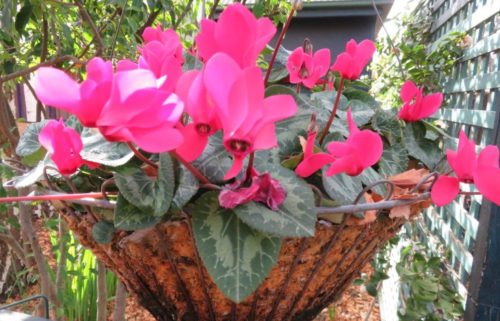
Gardening writer CEDRIC BRYANT suggests tough winter flowers to give the garden colour in the colder months.
THERE’S still time to plant winter flowering plants.
Primula, polyanthus, hellebore, bergenia, cyclamen, iris unguicularis, parahebe and viola hederacea will all flower from winter to early spring.
The latter two are great as groundcovers. Primula is an annual with pink, white or purple flowers. Polyanthus is often treated as an annual but I’ve been growing it undisturbed for several years and it continues to multiply.
Bergenia cordifolia has a couple of common names, Elephant’s Ears, due to its leaf size, and Pigsqueak, is due to the funny noise made when the leaves rub together. The botanical name, given in 1794, honours physician and botanist Karl August von Bergen. Bergenia is remarkably tough, tolerating conditions from -36C to +46C. It heralds from some of the severest conditions on earth from Siberia across to the Himalayas and China. It is perfectly suited to our comparatively mild local climate. Flower colours range from white to ruby red and purple.

STILL one of the world’s favourite pot plants, cyclamen persicum, flowering now and until early spring, can last longer than often thought. Google states that it’s “a compact flowering pot plant that may last one season only or perhaps the next”. I planted this one (pictured above) in this basket in 2000 and have photos in full flower in 2007! Except for regular feeding with my favourite organic Maxicrop seaweed plant nutrient, I’ve done nothing – neither the soil nor the liner in all that time has been changed. Some of the seeds over the years have fallen from our basket to the ground and are growing there quite happily. This photo was taken two weeks ago.
Another native of the harsh, rocky hillsides in Syria, Turkey and Lebanon where they have extremes of heat and snow, cyclamen thrives in pine forests in particular. It was recorded by plant hunters in the 1600s and cultivated in France by 1731.
The garden centres are brimming with this cyclamen; not only in pink but also with white, red and mauve flowers. If you buy it as an indoor pot plant, don’t throw it out when it finishes flowering and gone into dormancy for summer, plant it out in a shady spot in your garden. If no garden, lay the pot on its side until February/March. Then stand the pot upright, start to water and feed and away it will go, flowering for another season.
The Bedouins grate the semi-poisonous cyclamen roots and mix with lime. They scatter this on the surface of lakes or large bodies of water where there are abundant fish, who then eat and are stunned by this mixture, and easily collected by the fishermen. I am not suggesting you try this on Lake Burley Griffin!
CHECK out the local garden centre to see which vegetables are on the shelves. This is always an indication of which veggies should be planted now. Certainly chives and onion seedlings can go in. My broad beans are really taking off, as are the peas, and English spinach was planted today. With so many folk suddenly growing their own veggies, perhaps thinking there will be a shortage like toilet paper, I am told that both veggie seedlings and seeds are disappearing off the shelves as fast as they arrive!
Who can be trusted?
In a world of spin and confusion, there’s never been a more important time to support independent journalism in Canberra.
If you trust our work online and want to enforce the power of independent voices, I invite you to make a small contribution.
Every dollar of support is invested back into our journalism to help keep citynews.com.au strong and free.
Thank you,
Ian Meikle, editor




Leave a Reply